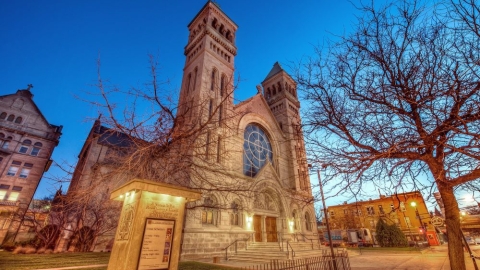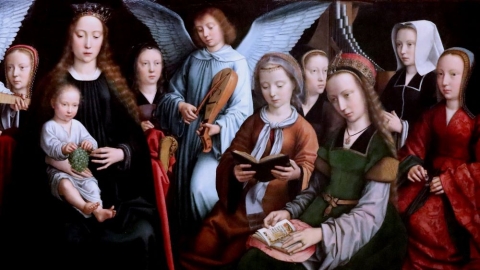The Worship Due to the Mother of God

The Most Holy Virgin’s very specific position through her title as Mother of God, her very great sanctity, her role after Christ in our redemption and in our sanctification, explains that she must receive from us a particular type of veneration. Some are opposed to it, objecting that it detracts from the worship due to her Son.
Holy Scripture gives us a solid reason
The evangelist St. Luke, wrote: “Blessed are thou among women (1:28)”; and again, “blessed art thou among women (1:42).” And finally: “from henceforth all generations shall call me blessed (1:48).”
The monuments of Tradition
Frescoes from the second and third centuries depict Our Lady seated and surrounded by saints who are standing. Further, the Holy Virgin was included in the Communicantes [the invocation of the saints] of the canon of the Mass by the end of the 5th century. And the basilica of St. Mary Major was built in A.D. 440.
Countless sermons of the Fathers after Ephesus, as well as poems in her honor, were written during the sixth century. The sixth and seventh centuries saw the appearance of the feasts of the Nativity and the Assumption of the Blessed Virgin Mary.
Spiritual literature affirms that Marian devotion is a sign of predestination, while contempt for her is a sign of reprobation (St. Anselm, St. Bernard, St. Louis-Marie).
Magisterium
The Second Council of Nicea, in 787, affirms that images of the Blessed Virgin Mary are venerable and should be presented to the faithful for veneration (while the other saints and martyrs are only mentioned in general). Subsequently, all the statements of the Magisterium in defense of the cult of images explicitly mention those of the Blessed Virgin.
The Code of Canon Law (1917), c. 1255, §1: “to the Blessed Virgin Mary, the cult of hyperdulia [is owed].”
Theological explication
The eminent sanctity of the Mother of God creates a cult of dulia, or of veneration – which is distinguished from the cult of latria, or of adoration, which is due only to God. Nevertheless, there is a radical difference between the excellence proper to the Mother of God and that of the saints—even if only according to her personal sanctity. This specifically distinct motif of honor creates a distinct cult called hyperdulia.
This cult is addressed to a person who enjoys the fullness of her being, unlike that of the non-resurrected saints, who are no longer, strictly speaking, human persons.
Response to the objection
The cult rendered to the Mother of God is not detrimental to that of Christ, rather, it leads to Him.
--The honor rendered to the creature is a recognition of the beneficences of the Creator.
--Our Lady is only entitled to this cult because she is the Mother of Jesus, so honoring Mary is honoring Jesus.
--The Holy Virgin repays this devotion through a greater abundance of grace, which leads to better worship of God Himself.
Insofar as the Church renders veneration towards the saints in the liturgy, just as all the faithful must join in the Church’s prayer, it can be said that worship towards the Mother of God is obligatory on this account. But private devotion remains free: it is not the object of any precept, except to clerics, who are bound by canon law to recite the rosary.
Related links
Illustration : Flickr / Fr Lawrence Lew, O.P. (CC BY-NC-ND 2.0)





